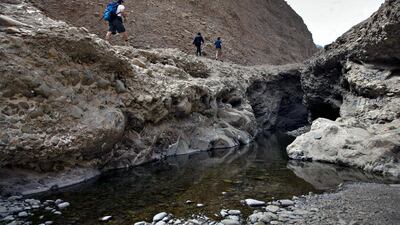A new campaign to protect wetlands across the UAE - and the diverse species that inhabit them - will be developed at a strategic meeting next month.
More than 20 representatives from government and environmental organisations will meet in Sharjah to develop a regional strategy for wetland and waterbird management in early September.
Mangroves forests are sanctuaries to breeding fish, birds, and insects and are a powerful carbon sink.
The UAE has seven sites designated as Wetlands of International Importance but mangroves continue to be demolished for coastal developments in the northern emirates.
The most recent area to be added to the list was Al Zora in Ajman last July, which features mangroves and mudflats and is home to 87 species of birds, including flamingos and the vulnerable greater spotted eagle.
Abu Dhabi's massive Bul Syayeef, which covers 14,500 hectares across the Mussaffah Channel, is host to nearly 3,000 breeding pairs of the greater flamingo and dugong.
Dubai’s Ras Al Khor lies deep in the Creek and is hope to more than 20,000 migratory waterbirds. On the East Coast there are the mangroves at Khor Kalba and Wadi Wurayah National Park where fresh water flows through springs, pools and waterfalls.
______________
Read more:
Death of marine life and waste management: threats to Abu Dhabi's environment revealed in annual report
Third of Gulf's marine life could be extinct by 2090, study finds
UAE biodiversity action plan to save sharks from extinction unveiled
______________
The UAE's first national park, Wadi Wurayah in Fujairah, recently won Unesco Biosphere Reserve status.
The wadi’s pools, streams and waterfalls support a rich variety of wildlife that include the Omani owl and the urothemis thomasi dragonfly, which was so rare it had not been sighted since 1957 and was thought to be extinct.
The Eastern Mangroves in Abu Dhabi are another huge tourist attraction, as well as being a hotbed for water-based species.
Participants at the two-day workshop, "Developing a regional strategy for monitoring of coastal wetlands and waterbirds in the Arabian Peninsula" will draft a regional waterbird and wetland monitoring strategy, track existing local, federal and regional initiatives and identify strategic conservation gaps. Additionally, they will shore support for the implementation of wetland management with regional stakeholders.
The workshop is organised by Environment and Protected Areas Authority in coordination with Wetlands International and BirdLife International.
The Sharjah workshop will lay the groundwork for a local monitoring strategy before the 13th Meeting of the Conference of the Contracting Parties to the Ramsar Convention on Wetlands in Dubai. It will be hosted by the Ministry of Climate Change and Environment from October 21 to 29 and is expected to attended by 1,000 participants.

